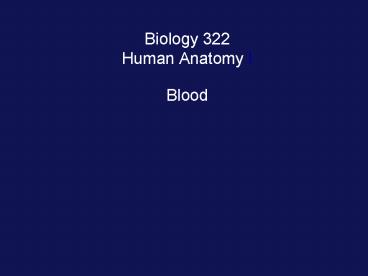Biology 322 Human Anatomy I - PowerPoint PPT Presentation
1 / 20
Title:
Biology 322 Human Anatomy I
Description:
Title: Biology 211 Anatomy & Physiology I Author: wsu Last modified by: setup Created Date: 9/3/2002 6:59:44 PM Document presentation format: On-screen Show (4:3) – PowerPoint PPT presentation
Number of Views:89
Avg rating:3.0/5.0
Title: Biology 322 Human Anatomy I
1
Biology 322Human Anatomy I
- Blood
2
Blood Volume Components Formed
Elements
Plasma pH
3
(No Transcript)
4
(No Transcript)
5
Erythrocytes Primary Function Biconcave
disks 4.5-5.5
million per cubic millimeter 4.5-5.5 billion per
milliliter (cubic cm) Slightly higher in men
Normally survive
6
Leukocytes (White blood cells) Five different
types of cells
All formed in bone marrow 4,000 to 10,000 per
cubic millimeter or 4,000,000 to 10,000,000
per milliliter (cubic centimeter)
7
Each type has specific functions, but in
general Leukocytes function in body defenses
by Engulfing digesting invading organisms
debris Directly killing invading cells
Producing antibodies Secreting chemicals
which activate other immune cells Secreting
chemicals which promote inflammation
8
Leukocytes Grouped into two Categories Abun
dant, distinct granules
Few, small granules
9
Granular Leukocytes Named according to how
these granules react to routine lab
stains ("Wright's Stain" is most common)
The nucleus of each type also has a
characteristic shape and/or density
Three types
10
Neutrophils Granules
Nucleus Also called
11
Eosinophils Granules
Nucleus
12
Basophils Granules
Nucleus
Outside of circulation
13
Agranular Leukocytes Two unrelated types of
leukocytes, neither of which has
abundant granules
The nucleus of each type also has a
characteristic shape and density
14
Monocytes Nucleus Cytoplasm
Outside of circulation
15
Lymphocytes Nucleus Varying amounts of
cytoplasm
16
Lymphocytes Two types of Lymphocytes
17
All leukocytes formed in bone marrow, then enter
blood But
18
Since they generally function outside of the
circulatory system, primarily in the connective
tissues of other organs, All leukocytes can leave
(and most can also reenter) the blood vessels by
a process called
19
Platelets
250,000 to 500,000 per cubic millimeter
or 250,000,000 to 500,000,000 per milliliter
(cubic centimeter)
20
Platelets Fragments































